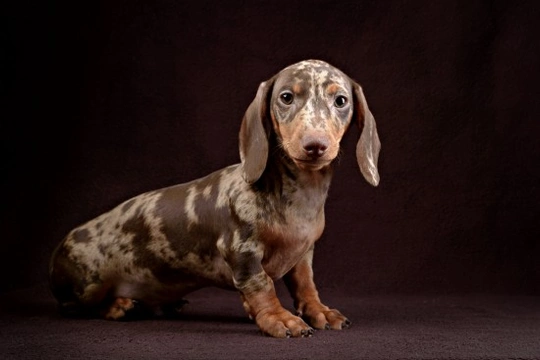
Double dapple Dachshund dogs and their problems
The Dachshund is a popular small breed of dog that is also sometimes known as the “sausage dog,” thanks to their short legs and long bodies! While their appearance is fairly unusual, the Dachshund’s shape and build actually helped them to fulfil their original working purpose, which was to pursue pests into their burrows below the earth, which other dogs were unable to access.
However, despite their popularity, the Dachshund breed’s build and conformation can pose a potential problem for the breed, due to the length of their backs in relation to their height. When these traits are exaggerated or overtyped, they may potentially lead to spinal problems, as well as a serious condition called Dachshund paralysis.
One of the main goals of The Kennel Club and Dachshund breed organisations such as the Dachshund Breed Council is to improve the health and wellness of the breed in perpetuity, and work to breed out any undesirable traits from the breed, such as those that may adversely affect the health, longevity or quality of life of dogs of the breed.
While Dachshund paralysis is perhaps the best known of the breed-specific health problems that can affect the Dachshund dog, another issue has also come to the attention of the relevant organisations that may potentially have even further reaching implications for dogs of the breed. It is actually an issue that has arisen from selective breeding to produce a certain colour variant within the breed, known as the “double dapple” colour.
If you are a Dachshund breeder, potential owner, or breed enthusiast, it is wise to find out more about double dappling, in order to gain a basic understanding of why the double dapple colouration is considered to be a negative breed trait, and what problems it can cause for affected dogs. Read on to learn more.
What is “double dapple?”
Double dapple is a coat pattern rather than a colour in its own right, and in order to fully understand what a double dapple is, first of all it important to understand what a simple or single dapple is!
Dappling is a type of coat pattern, which is also sometimes referred to as merle, and causes the coat’s pattern to be multi-coloured and patched or spotty in terms of the colour distribution. Genetics account for the dappling pattern on the dog, but results can vary quite widely, even within pups of the same litter, and regardless of the coat patterning of the two parent dogs.
If one parent dog is dappled in pattern, the puppies are also likely to present with a dappled pattern, and when just one parent passes on the dappled colour, this is not considered to pose a problem.
However, if both of the parent dogs are dappled, they will both pass on the dapple gene, and the puppies will receive two copies of it; this is what produces puppies with the double dapple, and where the two dapples overlap on the coat, this produces a double dapple pattern.
The double dapple pattern is generally considered to look attractive and be desirable in and of itself, which leads many Dachshund breeders to attempt to achieve this look within their own litters.
However, the two copies of the dapple gene pass on more than just the double dapple colour; they also pass on a range of hereditary health problems to the subsequent puppies too, which we will now examine in more detail.
Why is double dappling a problem?
While not all dogs with the double dapple pattern will automatically be afflicted with problems, the gene responsible for the double dapple colour is known to significantly increase the risk of conformation issues and other health problems too.
The dapple gene is a dominant gene, and when two dogs with this dominant gene are bred, they effectively cancel each other out to produce a recessive gene for white colouring, which commonly leads to problems with the eyes and ears too.
Crossing two dapple dogs to produce double dapple puppies can cause the following flaws within the subsequent litter:
- Blindness
- Deafness
- Partial blindness or partial deafness
- Abnormally small eyes
- Malformed eyes
- Malformed ears
- Missing eyes
- Missing ears
- Congenital eye defects
While not all double dapple puppies will be afflicted with health problems related to their coat patterning and the genes responsible for it, the incidence rate of associated problems is high enough that both The Kennel Clun and the Dachshund Breed Council stipulate that two dappled Dachshunds should not be crossed with each other. Double dapple dogs fall outside of the breed standard for the Dachshund, as their colour trait is directly responsible for potentially serious health problems.
What does this mean for Dachshunds and their owners?
First and foremost, Dachshund breeders are strongly advised not to breed two dapple dogs, and not to seek to produce double dapple litters. Potential Dachshund buyers are also advised not to purchase double dapple dogs, both due to the propensity for health problems that such dogs possess, and also in order to reduce demand for double dapple dogs and so, place pressure on breeders not to breed double dapple litters.
The Kennel Club and the Dachshund Breed Council class the double dapple colour as “unacceptable” due to the health risks that accompany it, and double dapple Dachshunds are not eligible for registration with the Kennel Club as pedigree Dachshund dogs.



